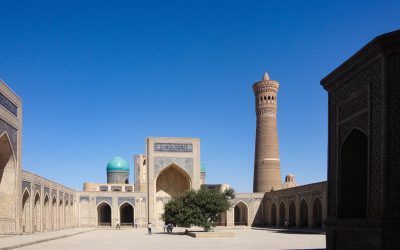BOLO HAUZ MUSJID
HERITAGE SITE | BOLO HAUZ MUSJID
-
Located on the western edge of the former registan (plaza), the Bolo Hauz stands opposite the Ark Fortress in a kosh (double) arrangement with the registan between them. Its name means “above the pool”, referring to the octagonal hauz (artificial pond) located directly in front of it. Begun in 1712, early in the reign of Abu’l-Faiz Khan (1711-47CE), it is one of the last and finest of Bukhara’s major buildings prior to the modern era.
-
The Bolo Hauz is a Friday usjid, large enough to host the special noon Jumu’ah prayers for a large percentage of the population. In practice, the Musjid served as the personal house of worship for the ruling Khan, who often traveled to and from his Ark palace with great pomp and ceremony.
-
The Musjid is a distinctive hybrid design built to accommodate Bukhara’s harsh climate—stifling heat in the summer months and bone-chilling cold in the winter. Architects adapted to these extremes by designing buildings with north or east facing iwans (portals) which were open on one more sides, providing ample ventilation and shade in summertime. During the winter months, the heavy brick walls coupled with fires lit on the inside provided the much-needed heat for the congregants. The expansive iwan (portal) on the east side of the building comprising a 20-pillared hall was used during the summer months.
-
The 42 meter-tall, delicately-carved wooden pillars made of walnut, elm, and poplar wood were added much later on the 20th century and add to the beauty of the iwan (portal).








